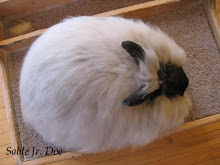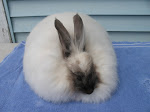--another post from the old blog
I was browsing through the Rabbit Production book again today (which I have said time and time again is my favorite rabbit resource:)), and I found an excellent description of the three most important factors in preventing disease in a rabbit herd. As everyone knows, illnesses such as Pasteurella (aka Snuffles) are among the most feared health problems in rabbits, and since there are virtually no vaccines available for rabbits, it is imperative that our herds are genetically sound and that we pay continual attention to the three factors mentioned in RP's 'Rabbit Diseases and Health Problems' chapter.
According to the book on pages 198-199, the three most important factors involved in disease control are Ventilation, Sanitation, and Observation.
1) Ventilation is crucial to healthy rabbitries because "air dilution" serves to reduce the concentration of harmful bacteria, viruses, and protozoa. This in turn gives the rabbit's immune system a better chance of fighting off a germ that may otherwise have overwhelmed it if the ventilation was poor and the population of these organisms increased.
2) Sanitation is the "physical or chemical" removal of potential disease causing organisms by scrubbing or through the use of disinfectants such as Bleach, Vanodine, or Listerine (for ex). Cage pans and floors should be kept clean, and hair and wool that is stuck to the wire in various places should also be removed. According to RP, "a single rabbit hair can carry thousands of bacteria or viruses".
3) Observation is exactly what it appears to be----keeping a close eye on how your rabbits feel from day to day. The problem with maintaining large rabbit herds is that it is easier to miss potential health problems due to the lack of time devoted to each animal. Watch your herd carefully and be aware of those who suddenly look peaked, unthrifty, or ill, or who stop eating and display signs that they are stressed or under the weather. Remove sick rabbits from the main herd immediately and isolate them in quarantine until you determine the problem and prevent the spread of contagious bacteria or viruses throughout the herd. Do NOT be soft on sick animals when they appear-----ANY sign of disease, particularly Pasteurella, should be dealt with immediately and the animal should be humanely disposed of if the disease proves incurable and the rest of your herd is at risk. Pet owners who keep a few isolated rabbits for wool may elect to pursue medical options that are available to forestall the effect of these diseases, but a show or production breeder cannot risk the health of an entire herd by coddling the weak and permitting disease symptoms to go unchecked:(.
Many individuals specialize in trying to prevent disease with the use of regular doses of antibiotics, products that keep ammonia smells down in the rabbitry, and the liberal use of drugs and medications when their rabbits get sick. All of these measures are expensive and usually unnecessary, and unfortunately serve to mask the root of a problem. The simpler solution is to breed for strong immune systems, keep the rabbitry as clean as possible, and make sure that there is an excellent exchange of air at all times. The importance of good nutrition should not be ignored either, as a rabbit in good health will be much more able to fight off disease than one who is malnourished. These tips are simple but effective, and all that any rabbit breeder needs to know to produce a healthy herd:).
Sunday, May 23, 2010
Subscribe to:
Post Comments (Atom)























No comments:
Post a Comment